The Rationale For Depth Control In Follicular Unit Extraction – FUE surgery: In Follicular Unit Extraction method of hair transplant surgery, using tiny punch tools to harvest grafts requires exerting precise control over how deeply the device is pushed into the skin to avoid injuring follicles. Advancing the instrument too far, past a certain point will increase the risk of grafts getting stuck in the punch, or becoming severed by the sharp edge. Therefore, hair transplant depth control for better coverage is achieved by preventing damage to the grafts. In this way, they can remain in their healthiest state and produce the expected growth.
Published On November 7, 2018. Last Updated on December 10, 2021.
The Dr.UPunch i ™ provides innate depth control through the following set of features working together with one another.
- An expanded external wall diameter
- Patented and patent pending graft gripping and pulling features
- Curved flaring of the punch tip which is directed away from the hair unit’s long trajectory
- Dr.UGraft ™ fluid system which provides lubrication on the inner surface of the punch
- Dr.UGraft’s hands-free graft rescue technology which overcomes the issue of impacted grafts
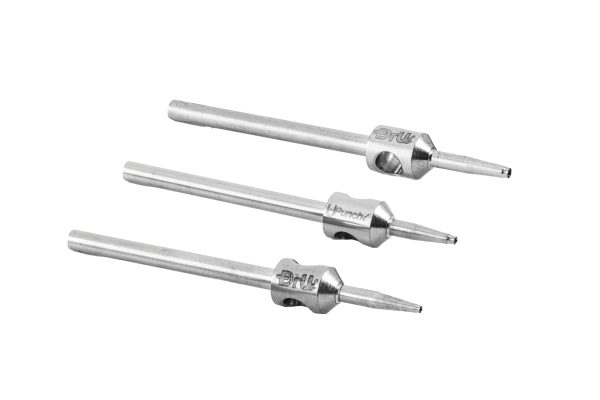
Dr.UGraft® Zeus FUE Hair Transplant System basic intelligent punch
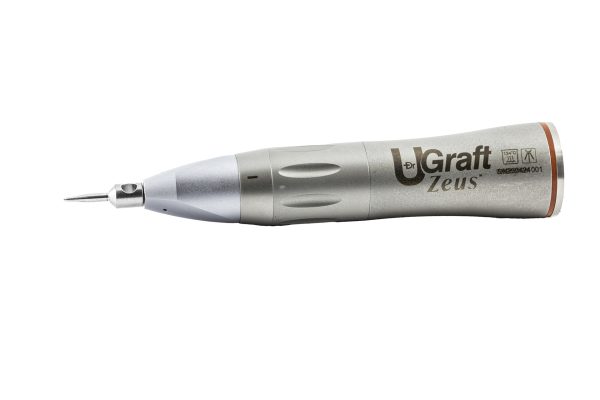
Dr.UGraft® Zeus FUE Hair Transplant System handpiece with basic intelligent punch
The Dr.UGraft system includes a wide range of smart and intelligent features built into the devices and components, such as innate, built in hair transplant depth control for better coverage
How Ignoring Hair Transplant Depth Control Leads to Graft Injuries, Poor Survival, and Poor Baldness Coverage
In Follicular Unit Extraction, surgeons use tiny punches in the range of 0.6-1.2mm. These punches score around individual follicular unit grafts. Scored grafts are then harvested transplantation. This requires a considerable amount of skill and practice to extract healthy grafts while preventing injuries. Advancing the punch too far can damage the follicular unit. Such injuries can hurt the hair growing processes, leading to poor survival and poor baldness coverage after the grafts are implanted into the recipient areas of the scalp. Therefore, it is absolutely necessary to consider hair transplant depth control for better coverage.
Lack of Proper Depth Control Results in Hair Transplant Graft Impaction and Graft Transection
The basic concept of an FUE punch is to simply cut around the follicular unit. But an awareness of how deep the device should go is essential for avoiding graft injuries. Techniques that do not compensate for punch depth dynamics would carry a higher risk of graft damage. This, in turn, translates to the inability to achieve better coverage.
Graft injuries from hair transplant punches may occur when proper depth is not taken into account. These are the typical scenarios that result:
Impacted Grafts in the Punch Lumen
Impaction occurs when grafts become stuck inside the punch. During the scoring of the hair follicle, the top part ascends into the interior lumen of a conventional FUE punch. Impaction will likely occur. One form of injury that may arise is when the upper part of the graft gets stuck inside the punch and the lower part remains out of the punch. As the punch continues to advance down the length of the follicle, it may crush and transect the lower portion of the un-ascended hair graft.
Mechanisms in hair transplant depth control for better coverage prevent the punch from advancing too far, thus avoiding these types of issues.
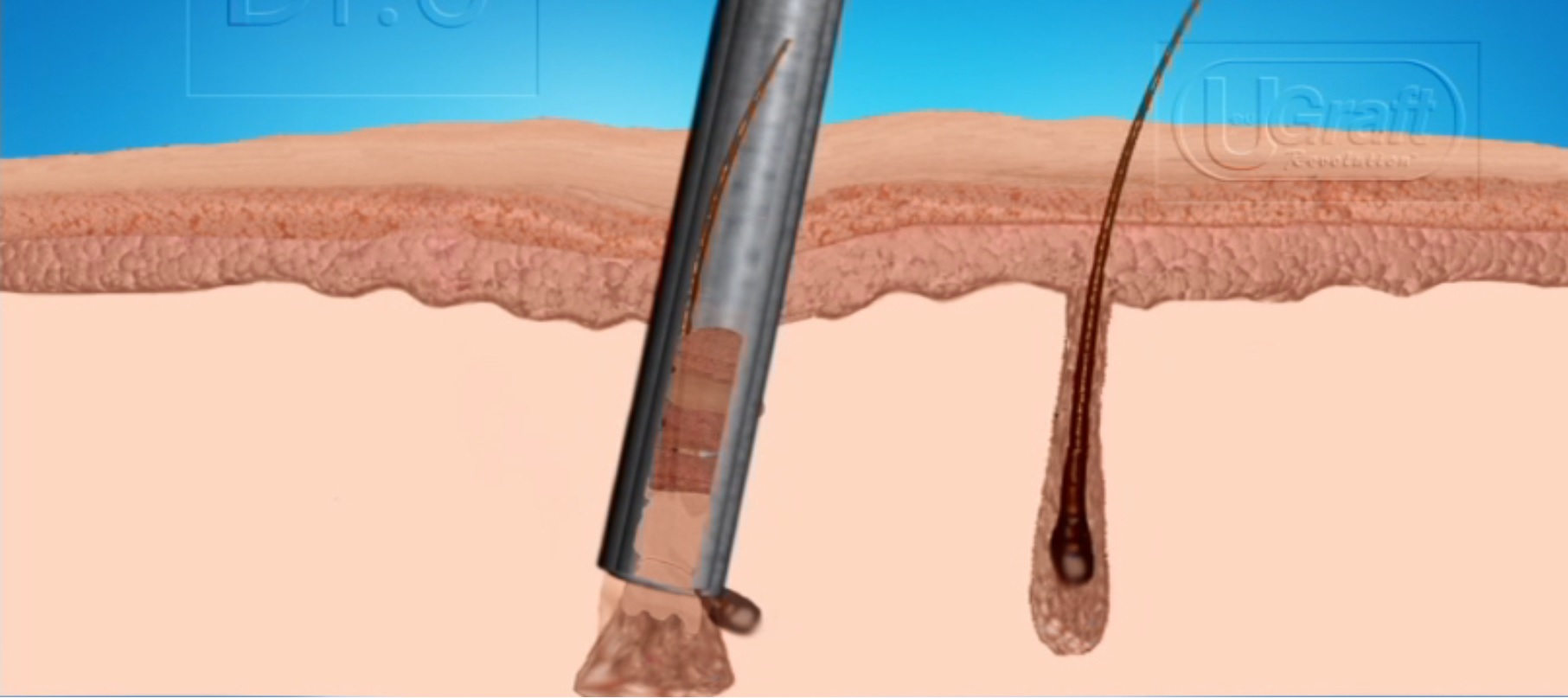
Linear Scar Free Hair Transplant Graft Transection of Splayed Hair Follicles
Groups of 2 more follicles wrapped in a fatty tissue sheath are naturally occurring follicular units. In the lower section, the tail bulb ends fan out and away from each other. When applying a conventional FUE punch in this context there is a high risk of transecting the splayed ends.
Upon rotation, these general extraction instruments will exert cutting vectors that may point straight down. When the punch end is beveled, the cutting vector may point or inward towards the follicular unit. With the case of multiple follicles in a follicular unit, the punch is likely to cut the splayed ends when it descends too far down.
Mechanisms in hair transplant depth control for better coverage prevent the punch from advancing too deep, thus avoiding these types of issues. Contraptions used to sleeve punches become functional once the practitioners determines sweet spot depth. The sleeve is then placed to prevent the punch from going past the depth it defines.
Not only is depth control necessary for extractions involving splayed hair follicles, but additionally, there is also a dire need for a much safer punch design that produces cutting vectors which point away from the graft unit, instead of towards it. The patented Dr.UPunch flare is an indispensable feature which makes this type of outward rotational cut possible. The flared, curved configuration, directs the sharp edge away from the graft. This minimizes the chance of follicular graft transection as the punch is pushed further into the skin.
General Depth Control Methods In Hair Transplant Surgery
A typical method of depth control involves the surgeon determining how far the punch is able to advance without the risk of transecting (i.e. damaging) the graft. First, practitioners perform a test extraction on a small number of follicles. This is to specify the average maximum length that the punch can actually descend. This is the sweet spot depth to aim for. Past this point, there is the risk of incurring unwanted injuries or consequences. Such injuries can include grafts getting stuck (i.e. impacted) inside the punch. By knowing exactly how far the device should go, the practitioner is able to mark this length on their punch with an adjustable plastic sleeve. This then allows them to pinpoint the exact depth limit, beyond which the punch should not advance.
Common Problems with General Depth Control Methods
Although this process to achieve hair transplant depth control for better coverage may seem very logical, implementing this type of approach within the context of actual surgeries can be cumbersome and time-consuming, especially when extracting thousands of grafts individually. The sweet spot depth will naturally shift throughout the course of the surgery due to different scalp terrains and hair characteristics. Given these new variables, practitioners must make new measurements with additional test extractions to find the new average depth limit.
Furthermore, the practitioner must constantly adjust the sleeve as the sweet spot depth changes from one area to another. And before changing the position of the sleeve, practitioners must once again engage in the step of extracting a new set sample follicles to determine the average depth of a score.
Dr.UGraft’s Built-In Hair Transplant Depth Control for Better Coverage
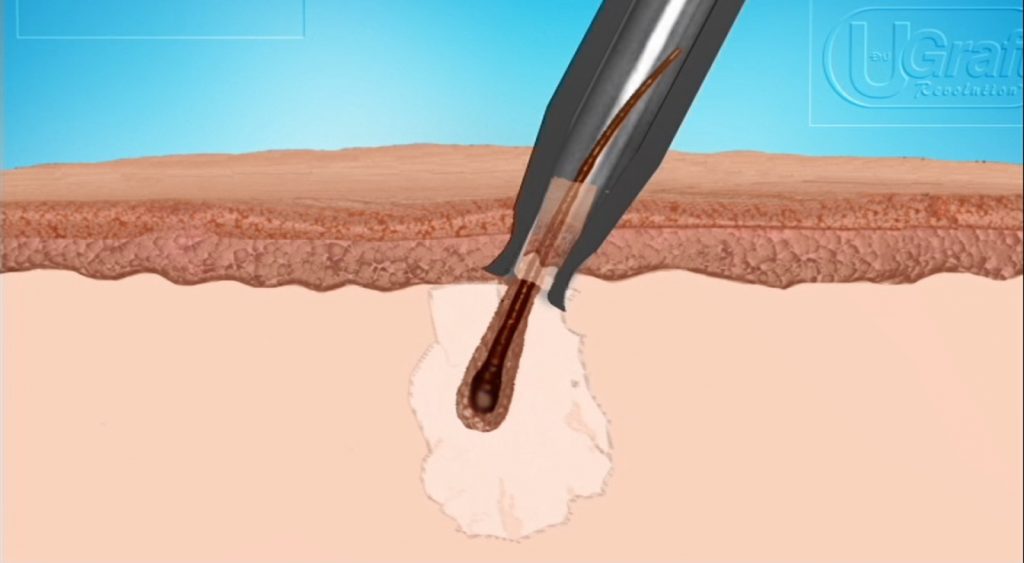
Photo showing the shallow, minimal depth needed for The Dr.UGraft rotary punch to successfully extract grafts. An upward pull replaces the need to push the punch downward to separate the follicle from its surroundings. Therefore traditional, depth-control methods in hair transplant surgery becomes non-relevant
Rather than adding new processes, mechanisms and devices to the Follicular Unit Extraction process, Dr.UGraft’s Dr.UPunch i ™ is engineered with simple, but highly effective FUE depth control features built into the device, giving practitioners the leeway to focus on harvesting grafts through a much smoother and uninterrupted momentum.
FUE hair transplant depth control for better coverage, The Dr.UGraft™ System achieves FUE hair transplant depth control for better coverage.
Gradual Volume Expansion
An expanded external wall diameter that increases with punch penetration depth into the skin, a feature present in some of the Dr.UPunch designs (Dr.UPunch i ™ ). The external wall diameter gets bigger as the punch travels further into the skin. This gradual volume expansion allows the instrument to encounter resistance from the skin tissue. It also serves as a natural, innate depth limiting feature that prevents the punch from progressing too far downward.
Graft Grip, Pull, Score, And Release Mechanism
Several patented and patent pending graft pulling features that pulls the graft up the lumen with less chance of impaction occurring. The upward pulling dynamic of the graft during scoring makes depth control a non-issue. This combined mechanism inherent to the Dr.UPunch i ™ replaces the need for deeper punch incisions. The simultaneous cutting and pulling are sufficient enough to fully extract and separate the graft from its surroundings, fulfilling the intended purpose of hair transplant depth control.
Unique Flared Tip
Curved flaring of the punch tip, directed away from the hair unit’s long trajectory, also enables a blunter section of the punch. This creates an all-in-one hybrid phenomenon that integrates the sharp and dull punch in a single structure.
In addition to the graft pulling features described above, the blunt region provides a smooth surface to help guide the follicle unit upward into the punch lumen without cutting or damaging it. Again, instead of having to advance the punch far down to separate the follicle from its tissue attachments (therefore making hair transplant depth control an absolute necessity) this gentle upward pulling dynamic, combined with the outward cutting of the flared end helps perform this separation instead. This unique mechanism achieves the aim of hair transplant depth control for better coverage.
Fluid Integration
Dr.UGraft™ fluid system which trickles a steady amount of fluid through the punch lumen to its tip lubricates the internal wall of the punch. This minimizes the chance of follicular graft impaction. Measures like fluid lubrication help prevent impaction diminish the need for depth control.
Hands Free Graft Rescue
Dr.UGraft’s hands-free graft rescue technology replaces the need for regular techniques to accomplish hair transplant depth control for better coverage by quickly and conveniently overcoming the issue of impacted hair follicles.
In other FUE methodologies and tools, one of the reasons for using depth control punch sleeves is to limit how far the punch advances. This is so that follicles don’t get stuck in the lumen and block the mouth of the punch. Once this occurs, the practitioner has to stop the extraction process to remove the impacted graft with forceps which adds more time to the overall surgical process. On the other hand Dr. UGraft’s hands-free graft rescue system uses a foot pedal to instantly activate a water irrigation system which expediently ejects impacted grafts.
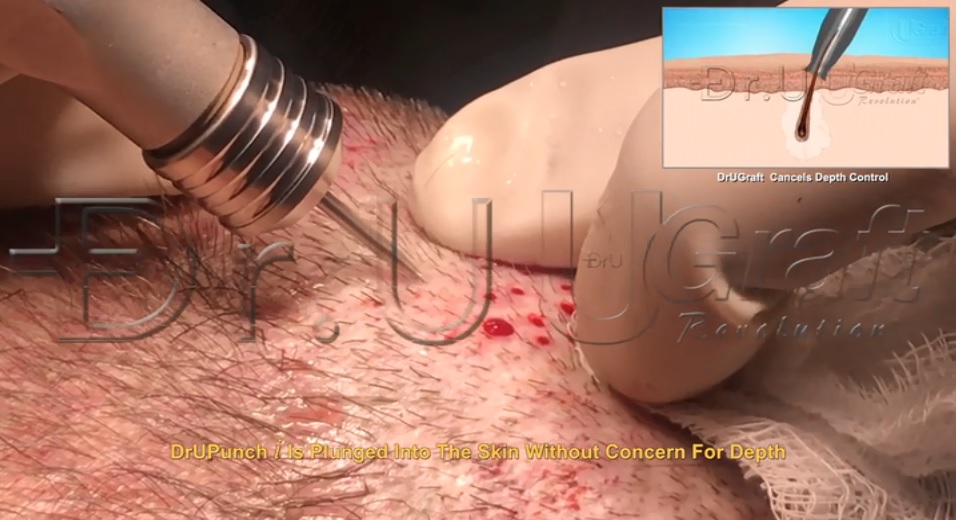
The Dr.UPunch i offers innate hair transplant depth control for better coverage. This is achieved in part through the gentle upward pulling feature.
Defining Depth Control to Prevent Shallow Incisions
Specifying the depth of the punch prevents it from going too deep into the skin. On the flipside, it also serves to guide the practitioner so that the punch incision is not too shallow. Shallow cutting depths incur a different type of consequence, allowing the follicular unit to only achieve a partial separation from the surrounding tissue environment. A significant portion of the anchoring apparatus remains intact. This necessitates a tedious secondary surgical process where the surgeon must complete the separation of the anchoring elements, adding to the overall surgical time needed to complete the procedure.
Without effective instrumentation, follicles can be rough-handled during extraction. This would then add another source of trauma to the grafts, reducing their chances of survival.
Video: See how Dr.UGraft™ Erases the Need for Depth Control Tools
Watch the video below to see how the above mentioned innovative groundbreaking elements come together in the Dr.UPunch i intelligent punch to act as an innate, intuitive form of depth control.
This video illustrates how Dr.UGraft ™ practitioners can perform more expedient extractions without having to focus on depth control.
Frequently Asked Questions – Hair Transplant Depth Control for Better Coverage
How do the majority of other linear scar free hair transplant surgery methods account for depth control?
Many doctors and practitioners rely on external devices and intricate systems. Such methods of measurement to limit the depth of the punch in order to avoid transection. However, they may run into obstacles when using the selected mechanism to set the depth control point. For example, they may set the point at the level of the sebaceous gland or the erector pili muscle. In other regions of the scalp, the system may require re-calibration to specify different points of depth limitations.
How does depth control result in better coverage?
Viable grafts can be destroyed by inserting a hair graft extraction tool too deeply. By preventing the punch tool from entering too deeply, the graft has a better chance of being extracted safely. This, then, supplies the patient with more grafts. The flared tip of the Intelligent Punch ™, as well as its gradual volume expansion, act as innate depth control devices to prevent this kind of injury– in addition to prevent graft injury from torsion and impaction.
Click the button to learn how to become a Dr.UGraft provider:
